Laguna Beach-based artist Marsh Scott knows no boundaries when it comes to creating masterful works of art.
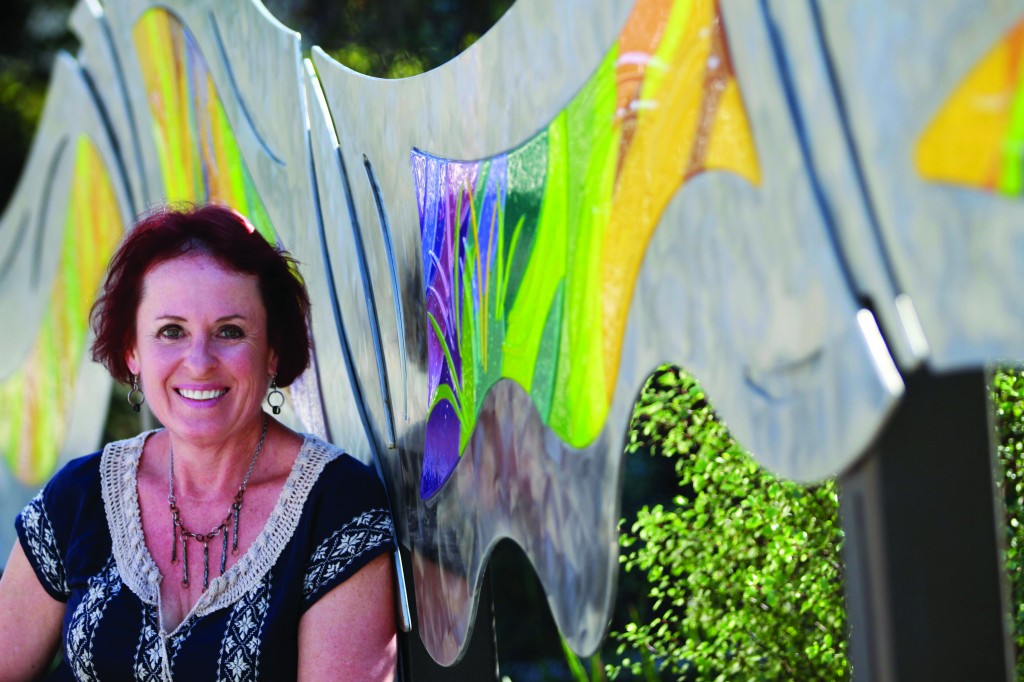
By Jennifer Pappas
Marsh Scott just may be the hardest-working artist in Orange County. In addition to being a longtime exhibitor at the Sawdust Art Festival and the recent winner of a competition that was part of Laguna Beach’s Broadway Streetscape Improvement project, Marsh has her hands—quite literally—in a variety of different projects around the country. From private commissions for hospitals and businesses to public works projects for colleges, churches and apartment communities, one gets the feeling that Marsh rarely turns down the opportunity to tell a story through art.
Driven by her surroundings and, in particular, by the history of an area, Marsh is widely known for her metal sculptures. However, she’s also a painter, photographer, stone carver and jeweler. Private, public, fragile, unwieldy—Marsh does it all. Here, Laguna Beach Magazine takes an in-depth look at the multifaceted artist’s techniques and inspirations to discover the unique trajectory of her modern art career.
Artistic Journey.
Born in Cleveland, Marsh earned a bachelor’s degree in art education from Pennsylvania State University before moving to California in 1974. From there, she spent five years teaching art at Foothill High School in Santa Ana; earned a master’s degree from California State University, Long Beach; married; moved to Newport Beach, where she lived for 20 years and raised twin boys before moving to Laguna; helped start a private after-school arts program called CDM Art Studio in Corona del Mar (now defunct) and taught art at Coastline Community College. It wasn’t until 1986, however, that Marsh resolved to become a full-time studio artist.
“I was doing a lot of different media at that time,” she explains. “The major one was handmade paper. … The largest piece I did was 22 feet.” Despite her commitment to the medium, a decade of strenuous pushing took its toll: “The paper-making started really hurting my wrists; I just decided to stop.”
She began devoting more time to abstract painting and working with metal. Like a swinging pendulum, she vacillated from one medium to the next. “I would be doing metal in one place, mixed-media or paintings in another,” she says. “I’ve always gone back and forth between the media. I’ve loved texture, and I’ve loved layers, so that’s kind of driven me to experiment with a lot of different things.”
Art consultant Lori Sklar has witnessed the full gamut of Marsh’s capabilities firsthand through a number of hospital commissions she’s contracted the artist to create. “Marsh understands the needs of site-specific commissions in health care installations and has successfully created unique concepts for each project reflecting geography, ethnicity, budget … and of course coordinating and enhancing interiors,” Lori says. “Marsh’s work provides a wonderful visual release in an otherwise stressful setting.”
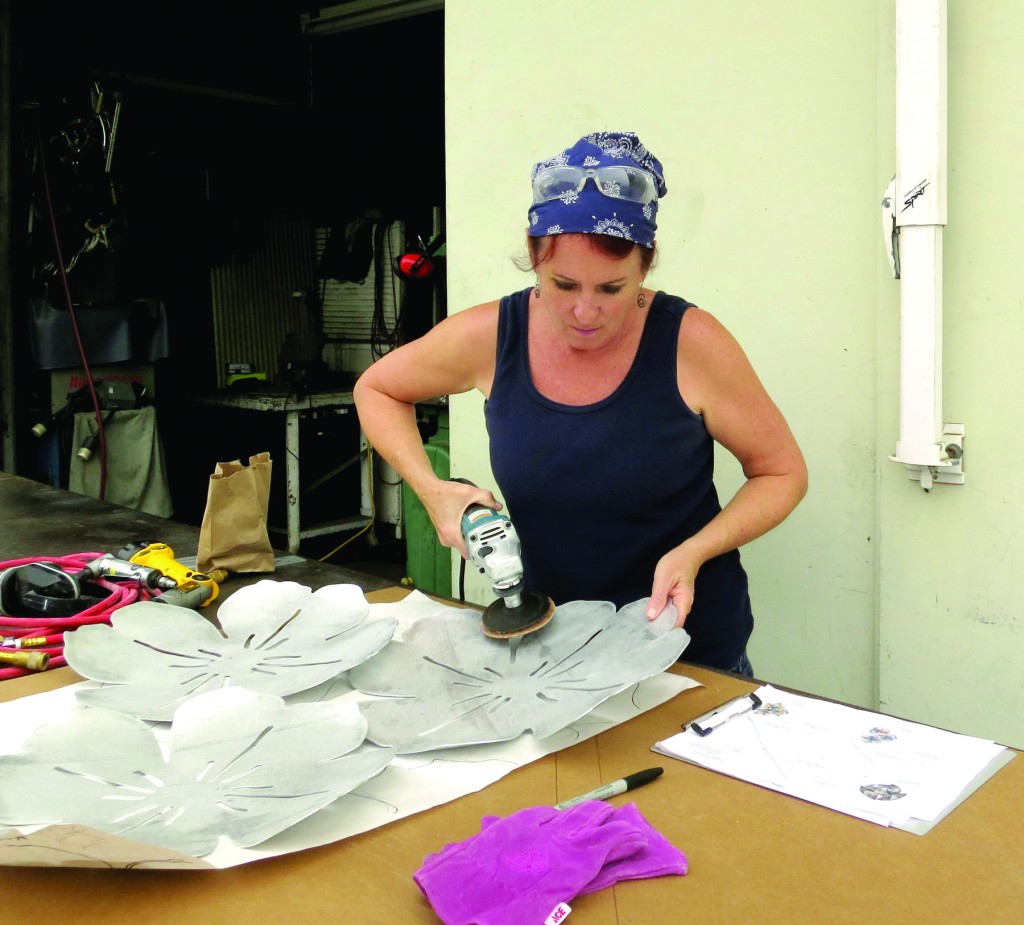
This keen ability to translate ideas and stories using a variety of materials has dictated an unusual path for Marsh, one fraught with accolades, discoveries and losses—all firmly rooted in Laguna Beach. Though Marsh was on the board of directors for the Sawdust Art Festival from 2005 to 2008—even serving as its president for the last two years—and was named Artist of the Year in 2010 by the Laguna Beach Alliance for the Arts, her artistic journey hasn’t always been so smooth.
In December 2010, Laguna Beach suffered a series of major storms, initiating a devastating domino effect of flooding, mudslides and irreparable property damage. Marsh, along with 21 other artists with studios in the canyon, felt the full brunt of the storm and reaped the consequences of its aftermath. “The flood really did shift everything,” she says. “I had to eliminate a number of mediums; I didn’t have the work to even put into galleries. That’s when I stopped doing the encaustics [a wax-based painting medium] because I lost most of everything. I lost hundreds of pieces of artwork plus supplies and tools.”
In the weeks that followed, artists watched as years of work were bulldozed out of the canyon. Marsh eventually gave up the studio, and with it, her career underwent another swing of the pendulum. “[I’m] working from home now,” she says. “My newest painting series, which I’ve just been doing since the flood, is on fresco. It’s another meeting of textures, layers, color. That’s typically how I morph from one thing to another.”
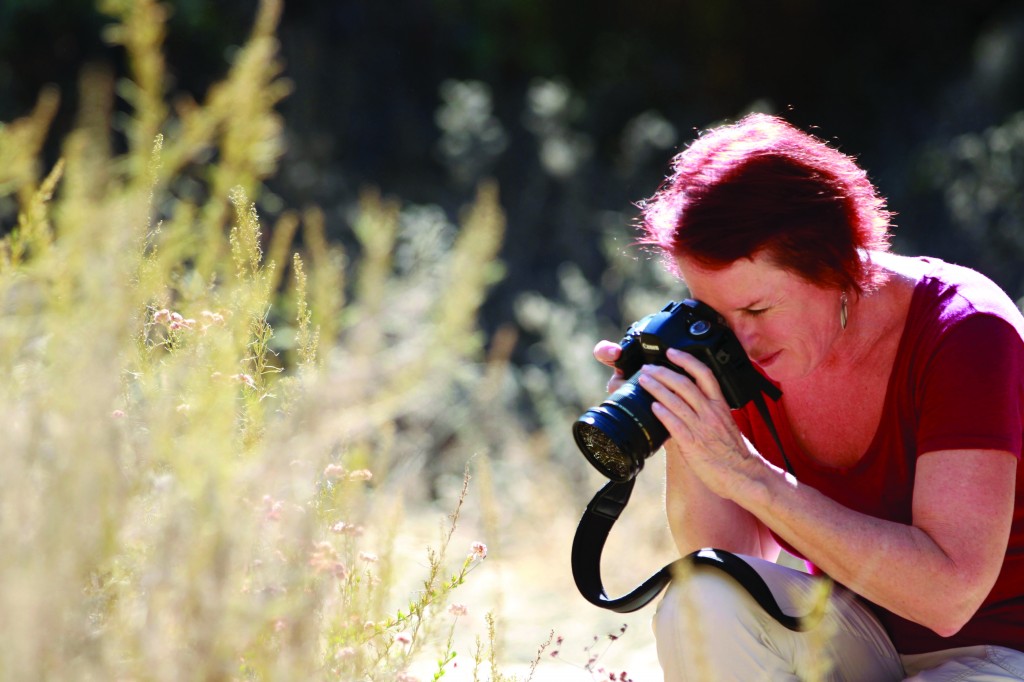
Reconstructing the Canyon
Marsh’s latest piece, Colors of the Canyon, debuted May 16, 2013, as part of the Broadway Streetscape Improvement project facilitated by Laguna’s city leadership. The public work is a direct result of her day-to-day experience living in Laguna. “My concept for the piece was to have it tell a story of the colors of the canyon, thinking in terms of how it changes through the seasons, going from up near the freeway all the way to the ocean,” Marsh explains. “I’ve done a lot of hiking in the canyon, and I often take my camera. For this piece, I looked back through some of my favorite photographs—the wildflowers and the grasses—and thought back to a couple of different studios I had in the canyon, one deep into Big Bend.”
The stainless-steel-and-stained-glass sculpture, strategically installed on a Broadway Street handrail between the bus depot and Forest Avenue, surges toward the Pacific Ocean in a bright, colorful wave. To hear Marsh describe it is to understand just how much thought went into each detail of the construction of the 4-foot-high, 72-foot-long tribute to the canyon.
“The piece starts on the left-hand side with the grasses—fluorescent green after the rains in the early spring—and then goes into golds and yellows,” she says. “In addition to the colored glass, I also put in some grass blades. The undulating shape of the piece was to indicate not the flow of water as some people have mentioned, but the actual undulation of the hills. When you drive Laguna Canyon Road, it’s gentle, but when you hike it, you certainly feel the hills more.”
Marsh used purples and dark greens to represent the dark shadows, shade and berries that the deer of the canyon’s Big Bend eat. From there the piece heads into town, colored by the banners, bright festivals, cars and crowds indicative of Laguna in the summer. The final section of the sculpture, which represents the ocean, is marked by fluid streaks of blue and turquoise, as well as shells and beach glass.
“Marsh Scott has been working in the public art field for many years. The [Laguna Beach] Arts Commission selected the work [from a pool of 25 submissions] for its fluid meandering shapes and colorful fused glass that depict the transition from canyon to ocean,” Laguna Beach Cultural Arts Manager Siân Poeschl says of the committee’s decision to feature Marsh’s piece.
Though the concept for Colors of the Canyon was entirely Marsh’s idea, she enlisted the help of fellow Sawdust Art Festival exhibitor Maggie Spencer to help navigate the complexities of working with a new medium, fused glass. The women worked in Spencer’s studio every Tuesday for nearly a year, developing a type of “paint by glass” technique that involved 26 different colors of glass and two clear samples.
Given Marsh’s penchant for throwing herself into the unknown, it comes as no surprise that Colors of the Canyon was her first foray into working with fused glass. “I knew Maggie was the perfect person to work with on this, so I just jumped right in,” she says. “I’ve always kind of taken those leaps. I dove into handmade paper; I dove into encaustics as a major painting technique.”
Her approach relies less on materials, and more on the underlying narrative buried beneath each project. “It tells a story,” she explains. “Much of my work does. Many of my metal sculptures and all of my public art projects tell stories.”
Sense of Place
Thematically, Marsh is driven by two elements: surroundings and history. Before even beginning to sketch or conceptualize, she does thorough research. “A lot of research goes into each project,” Marsh explains. “I love to hear that people appreciate how site-specific the pieces are. They become very protective and take ownership of them. If I’m not given a direction I always look to the natural history, the history of the area. I try to get to what is essential, what will be special to the people who see it—something that will be unique to that particular place.”
For Orange in Motion, installed in 2009 in the Metrolink pedestrian tunnel at Old Town Orange’s Santa Fe Depot, Marsh created a timeline composed of 22 historical moments. Warm tones greet commuters as they enter the tunnel in the morning, while cool tones representative of evening bid them farewell as they exit. Oversized orange leaves, blossoms and fruit float atop colorful waves in unexpected layers of paint and power-coated stainless steel. Marsh’s largest public art project to date, Orange in Motion is the epitome of her singular philosophy.
“Even with switching media, people can recognize my work. Even [with] my paintings, which are much more personal, expressive and abstract … there’s something identifiable. I think the gesture, my sense of balance, my sense of form and color has remained constant through the media,” Marsh adds.
Community Ties
Laguna has remained a constant in Marsh’s career. While her ability to understand the nuances of a place has resulted in highly successful public commissions around the country, on a more personal level, so has extracting inspiration from her home base.
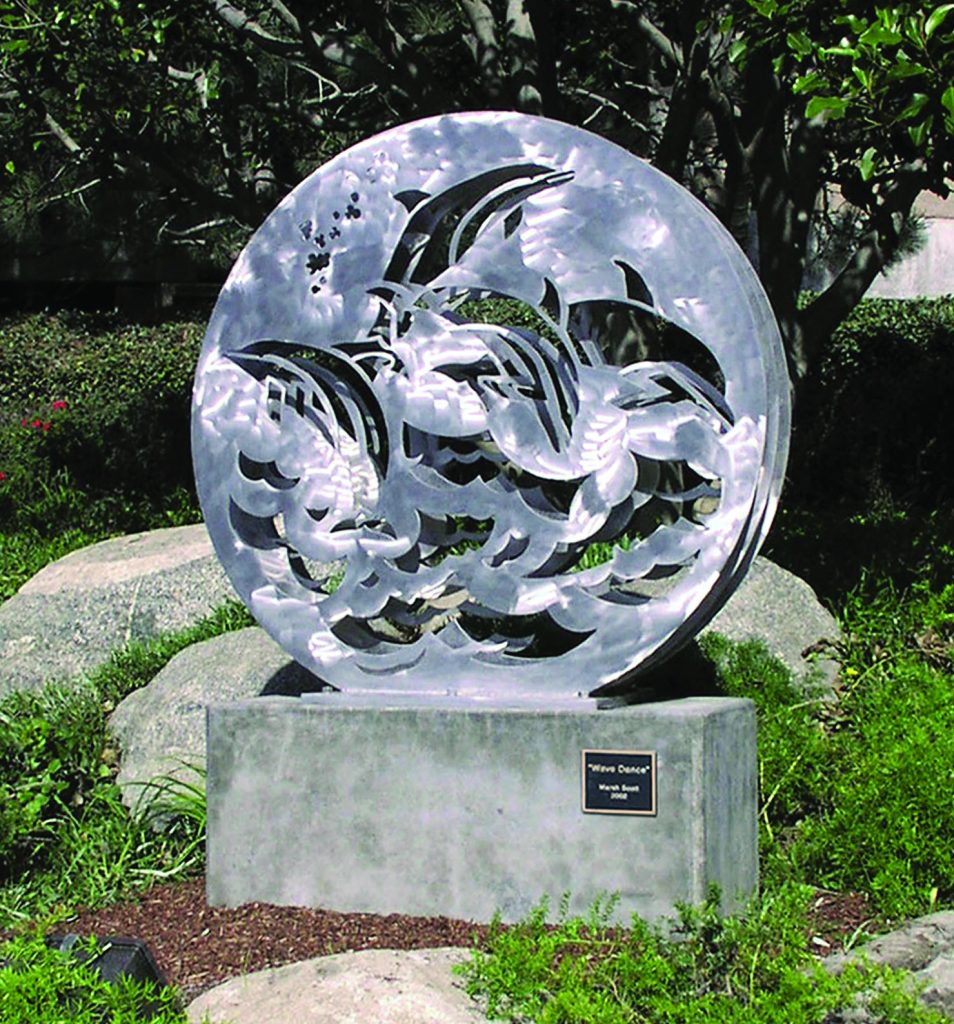
“When I have a creative solution I need to come up with—say I know the theme I want, I know the size, but I don’t have the imagery yet in my head or how it’s going to flow, poetry for my next painting—I hike the hills in Laguna, I go down to the ocean, walk on the sand, listen to the waves at night. … Laguna’s been really good to me, and then the flood has been the entire reverse, so it’s definitely been the full range of emotion for me,” she says.
Being surrounded by like-minded artists who face the same challenges and draw from the same inspirations that she does motivates and informs Marsh’s work. “It’s not about what we’ve just made; it isn’t just about the creativity and the creative process,” she explains. “We understand that most of us need time alone. It’s support, but it’s also competition. There are only so many sculptors here, and we keep going up against each other. And while I win mine, and they win theirs, living here as an artist has provided opportunities for friendship with artists and others who make the arts a priority in their life, opportunities for sculptural projects, and to exhibit, to sell and make art here, opportunities … to be part of an arts community.”
It’s opportunities like these that keep Marsh producing, thriving and consistently eager to try her hand at something new, something that hides a story only she can tell. LBM


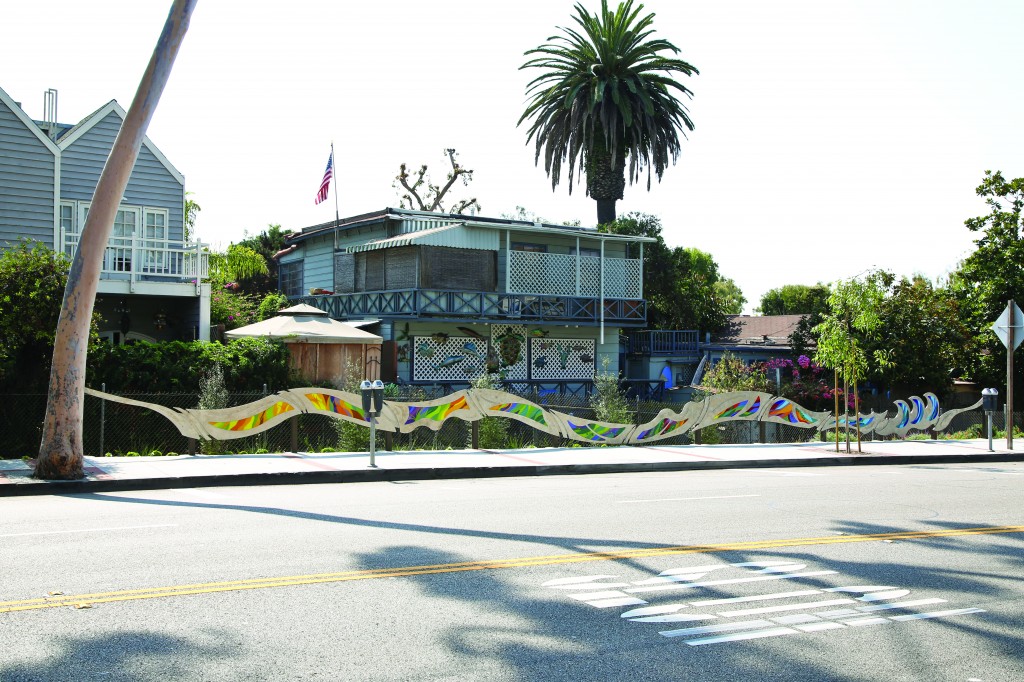
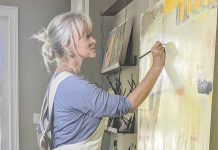
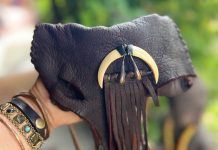
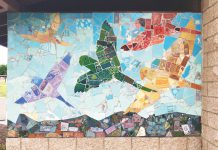
I like your work